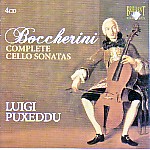Here we go again. Luigi Puxeddu claims to be an expert on the interpretation of 18th-century music. Maybe he is, but is he a great cellist? He plays these sonatas, which are basically duos for two cellos, cello and violin, or cello and viola, with a dry, largely vibrato-less timbre that makes his passage-work sound wiry and gives the sustained tones and lyrical melodies that horrible, “dying cow” quality typical of so much theoretically “authentic” cello playing. It also makes him sound intonationally challenged (which he may be anyway, judging from his handling of many of the more rapid flourishes in quick movements).
There are 26 sonatas here, none of them terribly long; most seem to be charming, but you’d never know it. Listening to them is torture, particularly given excessively close sonics that capture the players’ breathing with merciless vividness. If Puxeddu and his colleagues don’t want to use vibrato, and think that this is how music should sound, then let them rest their case on their prerogatives as interpreters, without hiding behind their intellectually shallow readings of inadequate historical sources. Of course they can’t do that, because then they would simply sound incompetent. And that is precisely the point.
































